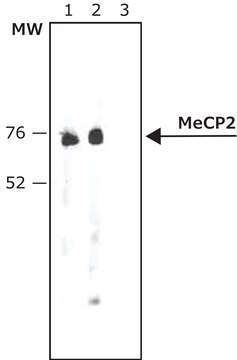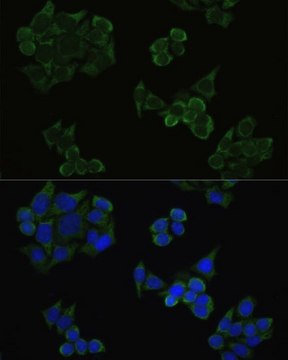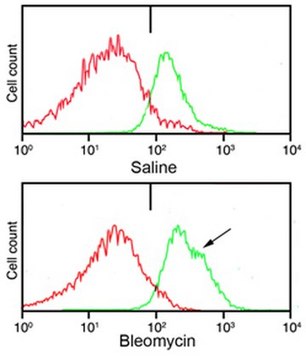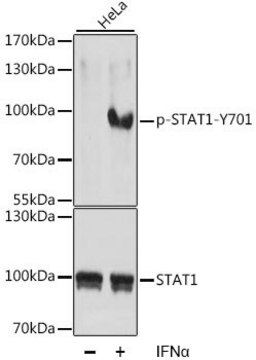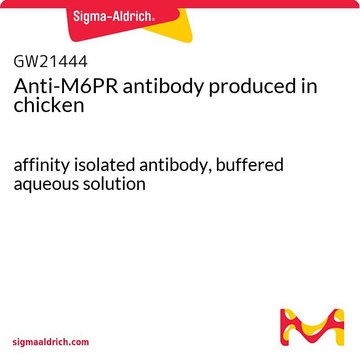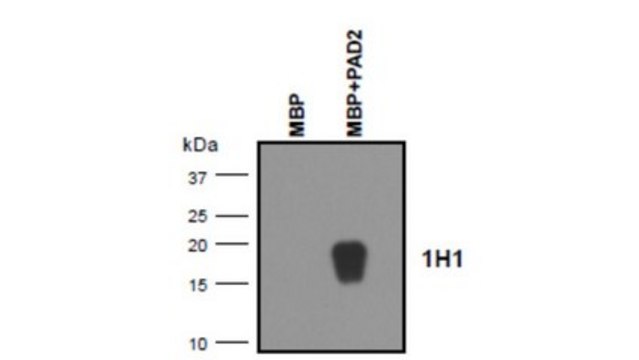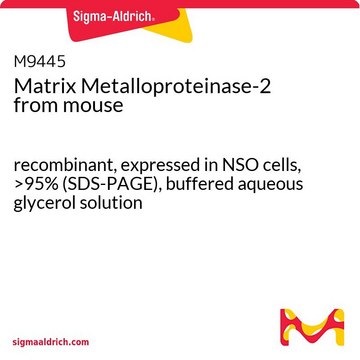MABF935
Anti-MPR300/IGF-2R/CD222 Antibody, clone 2C2
clone 2C2, from mouse
别名:
Cation-independent mannose-6-phosphate receptor, 300 kDa mannose 6-phosphate receptor, CD222, CI Man-6-P receptor, CI-MPR, IGF-II receptor, Insulin-like growth factor 2 receptor, Insulin-like growth factor II receptor, M6P/IGF2 receptor, M6P/IGF2R, M6P-R
登录查看公司和协议定价
所有图片(1)
About This Item
UNSPSC代码:
12352203
eCl@ss:
32160702
NACRES:
NA.41
推荐产品
生物来源
mouse
质量水平
抗体形式
purified immunoglobulin
抗体产品类型
primary antibodies
克隆
2C2, monoclonal
种属反应性
human
技术
affinity binding assay: suitable
immunocytochemistry: suitable
immunohistochemistry: suitable
western blot: suitable
同位素/亚型
IgG1κ
NCBI登记号
UniProt登记号
运输
dry ice
靶向翻译后修饰
unmodified
基因信息
human ... IGF2R(3482)
一般描述
Cation-independent mannose-6-phosphate receptor (UniProt P11717; also known as 300 kDa mannose 6-phosphate receptor, CD222, CI Man-6-P receptor, CI-MPR, IGF-II receptor, Insulin-like growth factor 2 receptor, Insulin-like growth factor II receptor, M6P/IGF2 receptor, M6P/IGF2R, M6P-R, M6PR, MPR 300) is encoded by the IGF2R (also known as CIMPR, MPRI) gene (Gene ID 3482) in human. Mannose 6-phosphate (M6P) receptors (MPRs) mediate the delivery of newly synthesized, mannose 6-phosphate-bound lysosomal hydrolases from the secretory pathway to the endosomal system. MPRs bind lysosomal hydrolases in the trans-Golgi network (TGN) and unload the enzyme in the endosomal system. There exist a cation-independent CI-MPR (IGF2R) and a smaller CD-MPR that requires divalent cations for lysosomal hydrolases recognition. MPRs also undergo recycling between the endosomal system and the plasma membrane, where CI-MPR mediates the internalization of other ligands, including insulin-like growth factor II (IGF-II). CI-MPR/IGF2R is produced with a signal peptide (a.a. 1-40), the removal of which yields the mature receptor with a large lumenal/extracellular region (a.a. 41-2304), a transmembrane segment (a.a. 2305-2327), and a cytoplasmic domain (a.a. 2328-2491), The extracellular region is composed of 15 P-type carbohydrate recognition domains, also referred to as MRH (mannose 6-phosphate receptor homology) domains. Domains 3 and 9 bind M6P with high affinity and domain 5 binds M6P with weak affinity, while domain 11 binds IGF-II.
特异性
Clone 2C2 targets the extracellular (lumenal) domain of IGF-II receptor (MPR). Clone 2C2 competed against IGF-II for MPR binding without affecting MPR interaction with pentamannose 6-phosphate (PMP) or beta-hexosaminidase, nor MPR-mediated beta-hexosaminidase endocytosis (Braulke, T., et al. (1988). Biochem. Res. Commun. 150(3):1287-1293; Braulke, T., et al. (1987). J. Cell Biol.;104(6):1735-1742).
免疫原
Epitope: Extracellular (lumenal) domain.
Recombinant full-length human MPR300/IGF-2R/CD222.
应用
Affinity Binding Assay: Representative lots were labeled with 125I and employed to bind and assess IGF-II receptor (MPR) on the surface of human fibroblasts (van Rahden, V.A., et al. (2012). Hum. Mol. Genet. 21(23):5019-5038; Braulke, T., et al. (1987). J. Cell Biol.;104(6):1735-1742).
Affinity Binding Assay: A representative lot competed against IGF-II, but not pentamannose 6-phosphate (PMP), for binding immobilized IGF-II receptor (MPR) (Braulke, T., et al. (1988). Biochem. Res. Commun. 150(3):1287-1293).
Western Blotting Analysis: A representative lot was labeled with 125I and detected the ~300 kDa IGF-II receptor (MPR300) in lysates from HeLa cells and primary human macrophages (Pohl, S., et al. (2010). J. Biol. Chem. 285(31):23936-23944).
Immunohistochemistry Analysis: A representative lot detected hepatocyte membrane and cytoplasmic M6P/IGF-2R immunoreactivity in normal human liver frozen sections. A reduced immunostaining of hepatocytes restricted to the sinusoidal part of the cell membrane and an increased signals in perisinusoidal cells was seen in cirrhotic livers (Sedlaczek, N., et al. (2003). Br. J. Cancer. 88(5):733-739).
Immunocytochemistry Analysis: A representative lot immunostained late endosomes in 2% paraformaldehyde-fixed, 0.01% saponin-permeabilized human fibroblasts (Bakker, A.C., et al. (1997). J. Cell Sci. 110 (Pt 18):2227-2238).
Affinity Binding Assay: A representative lot competed against IGF-II, but not pentamannose 6-phosphate (PMP), for binding immobilized IGF-II receptor (MPR) (Braulke, T., et al. (1988). Biochem. Res. Commun. 150(3):1287-1293).
Western Blotting Analysis: A representative lot was labeled with 125I and detected the ~300 kDa IGF-II receptor (MPR300) in lysates from HeLa cells and primary human macrophages (Pohl, S., et al. (2010). J. Biol. Chem. 285(31):23936-23944).
Immunohistochemistry Analysis: A representative lot detected hepatocyte membrane and cytoplasmic M6P/IGF-2R immunoreactivity in normal human liver frozen sections. A reduced immunostaining of hepatocytes restricted to the sinusoidal part of the cell membrane and an increased signals in perisinusoidal cells was seen in cirrhotic livers (Sedlaczek, N., et al. (2003). Br. J. Cancer. 88(5):733-739).
Immunocytochemistry Analysis: A representative lot immunostained late endosomes in 2% paraformaldehyde-fixed, 0.01% saponin-permeabilized human fibroblasts (Bakker, A.C., et al. (1997). J. Cell Sci. 110 (Pt 18):2227-2238).
Anti-MPR300/IGF-2R/CD222 Antibody, clone 2C2 is an antibody against MPR300/IGF-2R/CD222 for use in Immunocytochemistry, Immunohistochemistry, Affinity Binding Assay, Western Blotting.
Research Category
Inflammation & Immunology
Inflammation & Immunology
Research Sub Category
Vesicular Trafficking
Vesicular Trafficking
质量
Evaluated by Immunocytochemistry in HeLa cells.
Immunocytochemistry Analysis: A 1:250 dilution of this antibody detected MPR300/IGF-2R/CD222 in HeLa cells.
Immunocytochemistry Analysis: A 1:250 dilution of this antibody detected MPR300/IGF-2R/CD222 in HeLa cells.
目标描述
270.3 calculated. ~300 kDa reported (Pohl, S., et al. (2010). J. Biol. Chem. 285(31):23936-23944).
外形
Protein G Purified
Format: Purified
Purified mouse monoclonal IgG1κ antibody in PBS without preservatives.
储存及稳定性
Stable for 1 year at -20°C from date of receipt.
Handling Recommendations: Upon receipt and prior to removing the cap, centrifuge the vial and gently mix the solution. Aliquot into microcentrifuge tubes and store at -20°C. Avoid repeated freeze/thaw cycles, which may damage IgG and affect product performance.
Handling Recommendations: Upon receipt and prior to removing the cap, centrifuge the vial and gently mix the solution. Aliquot into microcentrifuge tubes and store at -20°C. Avoid repeated freeze/thaw cycles, which may damage IgG and affect product performance.
其他说明
Concentration: Please refer to lot specific datasheet.
免责声明
Unless otherwise stated in our catalog or other company documentation accompanying the product(s), our products are intended for research use only and are not to be used for any other purpose, which includes but is not limited to, unauthorized commercial uses, in vitro diagnostic uses, ex vivo or in vivo therapeutic uses or any type of consumption or application to humans or animals.
未找到合适的产品?
试试我们的产品选型工具.
储存分类代码
12 - Non Combustible Liquids
WGK
WGK 2
闪点(°F)
Not applicable
闪点(°C)
Not applicable
我们的科学家团队拥有各种研究领域经验,包括生命科学、材料科学、化学合成、色谱、分析及许多其他领域.
联系技术服务部门